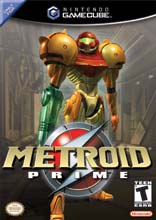
I hate scanning walls.
The opening sequence of Metroid Prime is about thirty minutes of turning on the scan visor and scanning the walls for information. It's not useful information either, but rather superfluous junk like "This is the door to the next room" that's obvious just from looking at it.
Of course, as I played through the meat of the game, I understood why I had
to put up with that boring half-hour of wall scanning. Metroid is listed in the gamer's thesaurus as a synonym for exploration, and Retro Studios hasn't
sold out the name in an effort to make a Halo clone for the
GameCube. Metroid Prime isn't about shooting everything you see to advance to the next area, but rather it's about immersing yourself in the world you've been put in. Scanning, while a bit tedious at times, is a part of that
exploration.
To help plunge you into the game's atmosphere, you view the world through the eyes of Samus. The first-person perspective has been debated for months by
lonely nerds on Internet message boards, but no other perspective would be
nearly as immersive and beneficial to the game as the one that's been
chosen. While Samus will visit the traditional ice, lava, forest and desert
worlds that are characteristic of nearly all Nintendo games, each world is
given its own life that goes just beyond being a backdrop. You'll explore
the lush Tallon IV overworld, the gloomy Magmoor Caverns and the somber
tranquility of the Phendrana Drifts, among other places.
Each area has its own subtle touches that make every place you visit
instantly memorable. Just when Prime starts getting too tense and dark for
its own good, you step into the snow-covered Phendrana Drifts, complete with
a soothing piano melody in the background.
The beauty is in the details, such as green insects flying around in the
rays of sunlight and packets of snow crumbling off the back of a
newly-awoken Sheegoth. Little touches like these aren't just exclusive to
the scenery, as they also extend to Samus herself. Flashes of bright light
in dark areas reveal Samus' eyes reflected in her visor. Heat waves come out
of the chamber of your weapon after long gunfights. My personal favorite
detail involves an enemy frozen by your ice beam disappearing entirely from
view if you have your thermal heat visor activated. These clever
touches show Retro's dedication to Metroid Prime, and this dedication
extends past the attention to visual nuance and into the gameplay itself.
There's almost too much fun involved in locking on to a Baby Sheegoth,
jumping over it when it tries to charge into you, and shooting at the soft
shell on its back to reveal the weak spot. While Halo fans will recognize
this sequence, doing it in Halo was nowhere near as intuitive or exciting as
it is here, and that's thanks to Prime's unique control setup.
Prime doesn't stick to the normal dual-analog movement system used in most
first-person games. Instead, the L trigger acts as it did in Zelda 64, as
both a strafe and an enemy lock-on. The control system may seem awkward at
first (especially using the R trigger to manually aim), but it soon grows on
you and you realize the necessity of it. You could manually try to keep your
crosshair on the speedy Metroids if you want, but you'd have an easier time
just going ahead and trying to shoot yourself in the face.
Unlike the new control scheme, contorting Samus' body into her famous Morph
Ball controls exactly as you'd expect, and that old double-jump trick
still works great. The screen even switches to a 2D side perspective during
many of the morph ball sequences.
Metroid fans should fondly remember rolling around every block of the map
and trying to blow up walls to reveal secrets, and that aspect of the game
is as much alive today as it ever was. Truly, that's what the heart of
Metroid has always been about, and Prime continues that tradition of
headache-friendly exploration and backtracking. It's exciting to get the
Spider Ball upgrade for your Morph Ball and use it to climb the walls to a
new area you couldn't previously reach. It's even more exciting to explore
that new area and find another new upgrade that helps you to access an
earlier area that you also couldn't reach. The whole game plays out in this
fashion, and while the process can get a bit predictable, there's no other
game where you'll jump onto a platform you couldn't previously reach and
then yell at that platform and remind it that you just beat it.
You could probably go on with your life having never played this game, but
that's like going through life without clothes. Metroid Prime is a necessity
to a worthwhile, fulfilled existence.
· · · omgninjas

